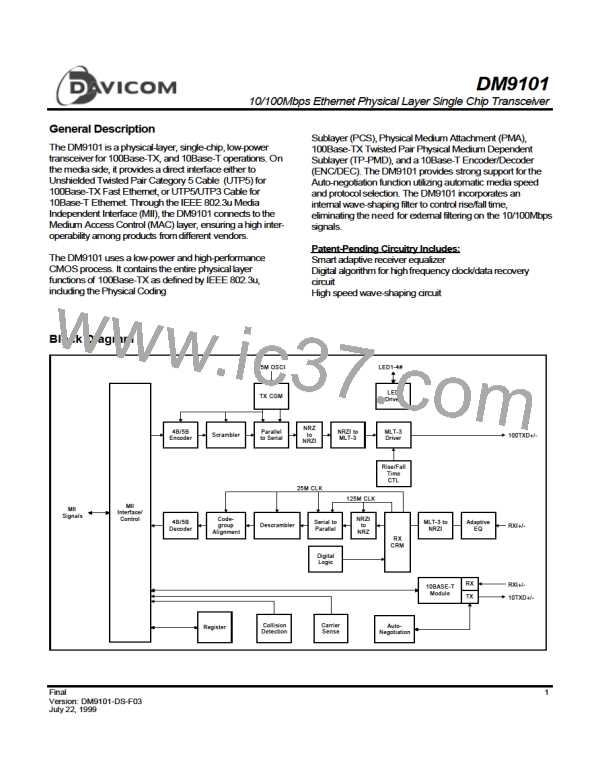DM9101
10/100Mbps Ethernet Physical Layer Single Chip Transceiver
D
Q
Q
.
CK
Binary plus
.
Binary In
C o m m o n
driver
MLT-3
Binary minus
Binary In
MLT-3
Figure 4
Digital Adaptive Equalization
100Base-TX Receiver
The 100Base-TX receiver contains several function blocks
that convert the scrambled 125Mb/s serial data to
synchronous 4-bit nibble data that is then provided to the
MII.
The receive section contains the following functional
blocks:
When transmitting data at high speeds over copper
twisted pair cable, attenuation based on frequency
becomes a concern. In high speed twisted pair signaling,
the frequency content of the transmitted signal can vary
greatly during normal operation based on the randomness
of the scrambled data stream. This variation in signal
attenuation caused by frequency variations must be
compensated for to ensure the integrity of the received
data. In order to ensure quality transmission when
employing MLT-3 encoding, the compensation must be
able to adapt to various cable lengths and cable types
depending on the installed environment. The selection of
long cable lengths for a given implementation, requires
significant compensation which will be over-kill in a
situation that includes shorter, less attenuating cable
lengths. Conversely, the selection of short or intermediate
cable lengths requiring less compensation will cause
serious under-compensation for longer length cables.
Therefore, the compensation or equalization must be
adaptive to ensure proper conditioningof the received
signal independent of the cable length.
- Signal Detect
- Digital Adaptive Equalization
- MLT-3 to Binary Decoder
- Clock Recovery Module
- NRZI to NRZ Decoder
- Serial to Parallel
- Descrambler
- Code Group Alignment
- 4B5B Decoder
Signal Detect
The signal detect function meets the specifications
mandated by the ANSI XT12 TP-PMD 100Base-TX
Standards for both voltage thresholds and timing
parameters.
MLT-3 to NRZI Decoder
The DM9101 decodes the MLT-3 information from the
Digital Adaptive Equalizer into NRZI data. The relationship
between NRZI and MLT-3 data is shown in figure 4.
Final
17
Version: DM9101-DS-F03
July 22, 1999

 ETC [ ETC ]
ETC [ ETC ]